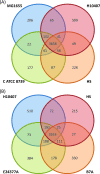A commensal gone bad: complete genome sequence of the prototypical enterotoxigenic Escherichia coli strain H10407
- PMID: 20802035
- PMCID: PMC2953697
- DOI: 10.1128/JB.00710-10
A commensal gone bad: complete genome sequence of the prototypical enterotoxigenic Escherichia coli strain H10407
Abstract
In most cases, Escherichia coli exists as a harmless commensal organism, but it may on occasion cause intestinal and/or extraintestinal disease. Enterotoxigenic E. coli (ETEC) is the predominant cause of E. coli-mediated diarrhea in the developing world and is responsible for a significant portion of pediatric deaths. In this study, we determined the complete genomic sequence of E. coli H10407, a prototypical strain of enterotoxigenic E. coli, which reproducibly elicits diarrhea in human volunteer studies. We performed genomic and phylogenetic comparisons with other E. coli strains, revealing that the chromosome is closely related to that of the nonpathogenic commensal strain E. coli HS and to those of the laboratory strains E. coli K-12 and C. Furthermore, these analyses demonstrated that there were no chromosomally encoded factors unique to any sequenced ETEC strains. Comparison of the E. coli H10407 plasmids with those from several ETEC strains revealed that the plasmids had a mosaic structure but that several loci were conserved among ETEC strains. This study provides a genetic context for the vast amount of experimental and epidemiological data that have been published.
Figures





Similar articles
-
A comparative genomic analysis of diverse clonal types of enterotoxigenic Escherichia coli reveals pathovar-specific conservation.Infect Immun. 2011 Feb;79(2):950-60. doi: 10.1128/IAI.00932-10. Epub 2010 Nov 15. Infect Immun. 2011. PMID: 21078854 Free PMC article.
-
Genome sequences and phylogenetic analysis of K88- and F18-positive porcine enterotoxigenic Escherichia coli.J Bacteriol. 2012 Jan;194(2):395-405. doi: 10.1128/JB.06225-11. Epub 2011 Nov 11. J Bacteriol. 2012. PMID: 22081385 Free PMC article.
-
Subtractive hybridization and optical mapping of the enterotoxigenic Escherichia coli H10407 chromosome: isolation of unique sequences and demonstration of significant similarity to the chromosome of E. coli K-12.Microbiology (Reading). 2006 Apr;152(Pt 4):1041-1054. doi: 10.1099/mic.0.28648-0. Microbiology (Reading). 2006. PMID: 16549668
-
Strategies to overexpress enterotoxigenic Escherichia coli (ETEC) colonization factors for the construction of oral whole-cell inactivated ETEC vaccine candidates.Appl Microbiol Biotechnol. 2012 Mar;93(6):2291-300. doi: 10.1007/s00253-012-3930-6. Epub 2012 Feb 16. Appl Microbiol Biotechnol. 2012. PMID: 22350259 Review.
-
Colonization factors of enterotoxigenic Escherichia coli.Adv Appl Microbiol. 2015;90:155-97. doi: 10.1016/bs.aambs.2014.09.003. Epub 2014 Nov 12. Adv Appl Microbiol. 2015. PMID: 25596032 Review.
Cited by
-
CexE Is a Coat Protein and Virulence Factor of Diarrheagenic Pathogens.Front Microbiol. 2020 Jun 30;11:1374. doi: 10.3389/fmicb.2020.01374. eCollection 2020. Front Microbiol. 2020. PMID: 32714302 Free PMC article.
-
Evaluating the pathogenic potential of environmental Escherichia coli by using the Caenorhabditis elegans infection model.Appl Environ Microbiol. 2013 Apr;79(7):2435-45. doi: 10.1128/AEM.03501-12. Epub 2013 Feb 1. Appl Environ Microbiol. 2013. PMID: 23377948 Free PMC article.
-
The tib adherence locus of enterotoxigenic Escherichia coli is regulated by cyclic AMP receptor protein.J Bacteriol. 2011 Mar;193(6):1369-76. doi: 10.1128/JB.00288-10. Epub 2011 Jan 7. J Bacteriol. 2011. PMID: 21216994 Free PMC article.
-
F9 fimbriae of uropathogenic Escherichia coli are expressed at low temperature and recognise Galβ1-3GlcNAc-containing glycans.PLoS One. 2014 Mar 26;9(3):e93177. doi: 10.1371/journal.pone.0093177. eCollection 2014. PLoS One. 2014. PMID: 24671091 Free PMC article.
-
ESBL-plasmid carriage in E. coli enhances in vitro bacterial competition fitness and serum resistance in some strains of pandemic sequence types without overall fitness cost.Gut Pathog. 2018 Jun 15;10:24. doi: 10.1186/s13099-018-0243-z. eCollection 2018. Gut Pathog. 2018. PMID: 29983750 Free PMC article.
References
-
- Benjelloun-Touimi, Z., P. J. Sansonetti, and C. Parsot. 1995. SepA, the major extracellular protein of Shigella flexneri: autonomous secretion and involvement in tissue invasion. Mol. Microbiol. 17:123-135. - PubMed
-
- Brown, N. L., S. R. Barrett, J. Camakaris, B. T. Lee, and D. A. Rouch. 1995. Molecular genetics and transport analysis of the copper-resistance determinant (pco) from Escherichia coli plasmid pRJ1004. Mol. Microbiol. 17:1153-1166. - PubMed
-
- Chaudhuri, R. R., M. Sebaihia, J. L. Hobman, M. A. Webber, D. L. Leyton, M. D. Goldberg, A. F. Cunningham, A. Scott-Tucker, P. R. Ferguson, C. M. Thomas, G. Frankel, C. M. Tang, E. G. Dudley, I. S. Roberts, D. A. Rasko, M. J. Pallen, J. Parkhill, J. P. Nataro, N. R. Thomson, and I. R. Henderson. 2010. Complete genome sequence and comparative metabolic profiling of the prototypical enteroaggregative Escherichia coli strain 042. PLoS One 5:e8801. - PMC - PubMed
-
- Chen, Q., S. J. Savarino, and M. M. Venkatesan. 2006. Subtractive hybridization and optical mapping of the enterotoxigenic Escherichia coli H10407 chromosome: isolation of unique sequences and demonstration of significant similarity to the chromosome of E. coli K-12. Microbiology 152:1041-1054. - PubMed
Publication types
MeSH terms
Substances
Grants and funding
LinkOut - more resources
Full Text Sources
Molecular Biology Databases
Research Materials

